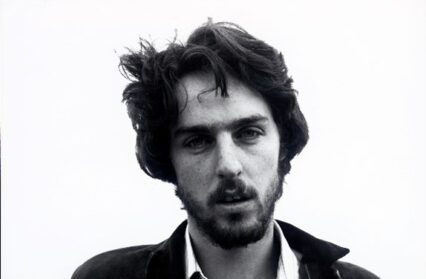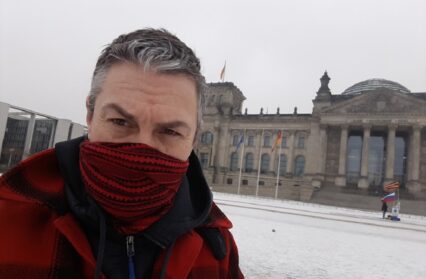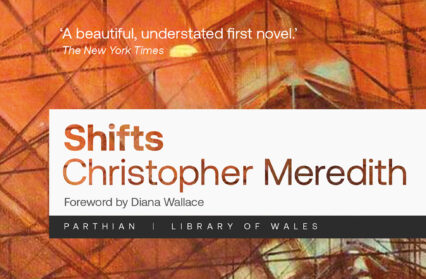In the first of a two-part mini-series Christina Thatcher, Garry Fabian Miller, Brennig Davies, Sophie Buchaillard, reflect, critically and creatively, on Garry Fabian Miller’s Môrwelion I The Sea Horizon photography exhibition which was displayed at National Museum Cardiff between February and September 2023.
Between February and September, specialists from Cardiff University’s Image Works research group conducted public poetry workshops and a lecture which offered opportunities to delve deeper into the exhibition. This mini-series features responses to The Sea Horizon from the artist, the academics as well as members of the public who attended the workshops. We hope these pieces contribute, at least in part, to representing the range of reflections inspired by these photographs.
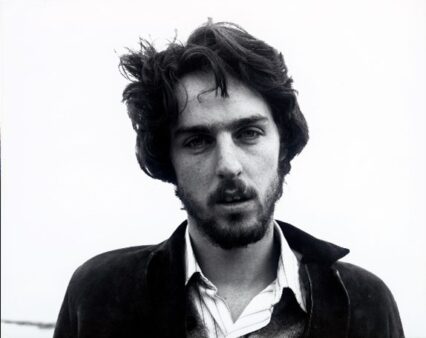
‘Môrwelion’
by Garry Fabian Miller
I looked into the edge-space of the world for the first time in 1976. I was just 19 when I stationed a square-format camera on the roof of my home in Clevedon and looked acros the Severn Estuary. From that moment I became a collaborator in a great performance, orchestrated by weather systems and the sun’s cycle.
For two years, the prospect of changing tide and sky was my universe. I began to understand how light makes an exposure of land and sea palpable, allowing it not only to be examined, but also to be absorbed and felt. I realised that human beings are silvered, light sensitive cells just like the materials of chemical photography. Over a lifetime, each of us builds an internal library of unique exposures like these forty fragments.
The squares of The Sea Horizon, 1976/7 represent the only significant body of work I have made with a camera. But they are the basis of my understanding of the essence of photography and of my belief that a commitment to a place can provide the foundation for a meaningful life.
They helped me find my way into the world. They helped me understand that looking across the water and upon the horizon might help me understand my role in the world.
My rooftop lens and shutter allowed me to investigate an illuminated space in perpetual flux and to capture its essence instant by instant, but I came to regard them as a mechanical encumbrance. I wanted to work with light directly and in 1985 I put my camera aside. Thereafter, the darkroom became my laboratory and the pivot of my daily observations. I examined the last of the sunlight as it seeped below the horizon, knowing that I was assimilating my exposure to the world. I took these physical impressions into the darkroom and retrieved them, for example by channelling a beam through a blue glass vessel filled with water and allowing it to fall upon light sensitive paper. From the darkness, I found I could release a unique image like The Frozen Sea.
The exhibition, Môrwelion, brought together the beginning and the end days of my work as an artist.
Last summer I stood on the foreshore at Penarth, for the first time I looked back across the Severn at the hillside on which I had stood in 1975/6 to make The Sea Horizons. I felt a sense of resolution knowing that the pictures had now found their true home within Amgueddfa Cymru – National Museum Wales. They are both an elemental portrait of the coastline of Wales and a meditation on the horizon.
As the six months of Môrwelion unfolded I’ve been touched by the messages, the poetry, the music that has been created and shared. I couldn’t have imagined that my earliest work as a young artist would have relevance and meaning to so many fifty years later.
I take hope from this.
Image: The Sea Horizon, No. 7, 1976-77
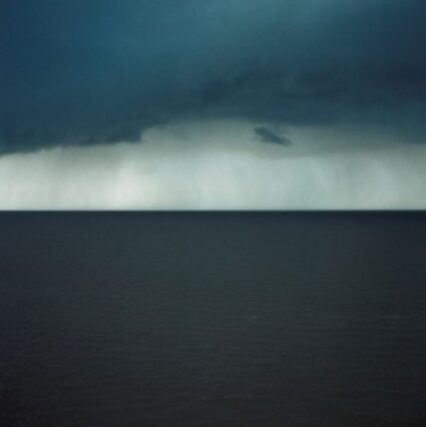
‘Great Beyond’
by Brennig Davies
And when all was said
and done, moorings dropped, it was embarrassing
to admit what we thought
we were looking for, so we said it was islands,
rare and precious plants, tribes
of inked men who’d never seen our like,
easier to say that it was science,
the advancement of knowledge,
that it was hubris, even, the stabbing
in of flags.
What we wouldn’t say,
even in the hush of ourselves,
was that we didn’t know
what we were looking for, but hoped
that we’d know when we found it:
ourselves,
a god,
a UFO,
or at the end of the dark corridor,
a door,
just slightly ajar,
the spill of radiant,
celestial light
from some other,
separate,
hallway.
Piece 3
Image: The Sea Horizon, No. 14, 1976-77
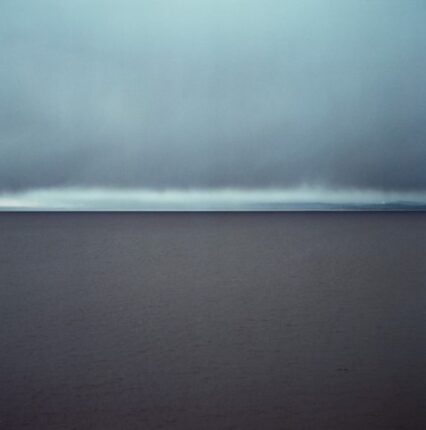
‘Imagined travels: a sea horizon journey’
By Dr Sophie Buchaillard
For centuries, the sea has inspired sailors and other travelers to embark on distant journeys. Taking inspiration from The Sea Horizon exhibition by Garry Fabian Miller, a retrospective of his first ever series, in which he captured the coastline of Wales from Clevedon over a period of two years (1976-77), the workshop ‘Imagined travels: A sea horizon journey’, held in the National Museum of Wales Cardiff, invited participants to explore the theme of imagined travels beyond the horizon, experimenting with modern forms of travel writing (non-fiction and fiction), where the journey becomes a metaphor for inner quest.
Travel writing as a genre has often been reduced to the first-person account of a journey to a distant land, from the narrow perspective of privileged white men from the West. Today, travel writing has started to reinvent itself as a hybrid form that combines fiction and non-fiction, storytelling, and a multitude of perspectives, looking out as a way to look in to ourselves. For the workshop, we focused on three aspects of the journey (a perspective view point; a motivation to travel; and the presence of movement – whether in time or space) to elicit what Garry Fabian Miller described as imagined landscapes of the mind: a journey both static (from the perspective of the eye of the camera), and moving through time, from the 1976/77 period when he captured those images, to this moment, fifty years later, when the images are finally exhibited in Wales.
Traditionally, travel writing has been associated with externalised forms of writing, travelling to a place, often to bring an image back for those left behind. In the era of the internet however, the far away has become at our disposal. As a result, the focus of travel writing has shifted from the physical to an inner journey. Movement becomes secondary to the reflection about the traveller, what Carolyn Merchant calls recovery narrative. And which is linked to the way we connect with nature. In Small Bodies of Water, nina mingya powles explores her identity between cultures in a book that blends memoir, criticism and nature writing, subverting the theme of water which often has a negative connotation in the context of migration, as a medium to explore stages in her life journey. She writes: My first body of water was the swimming pool. Underwater, I was like one of Gong Gong’s little silver fish with silver eyes. Like one of those catalogues and preserved in gold liquid in jars on the shelf in the room where I slept, trapped there glimmering forever. It was here that I first taught myself how to do an underwater somersault, first swam in deep water, first learned how to point my toes, hold my legs together and kick out in a way that made me feel powerful. Here, we spent hours pretending to be mermaids. But I thought of myself less as a mermaid and more like some kind of ungraceful water creature, since I didn’t have very long hair and wasn’t such a good swimmer. Perhaps half orca, half girl. Powles is looking back at the path that structured her identity. By contrast, in Soundings by Doreen Cunningham, the author embarks on a journey to follow whales’ migration with her two-year-old son, running away from a broken marriage. In the prologue, she writes: Wind spits spray in my face. Water slops against the sides of our small fishing boat as it shudders out of the harbour, into a dawn that billows fire above and below the horizon. Max, my two-year-old, is up front ‘helping’ drive the boat. I met the skipper, Chris, just twelve hours ago. We are borrowing a dad, one who has lived at sea and might be able to open a door into this secretive ocean. Today there is one last chance for things to go right. There is nothing to do except trust in this generous stranger, give myself over to the wind and the water, keep my eyes fixed on the waves, examining every curve, every roll, every swirl, every ripple. This journey is both recovery and identity shaping.
Reflecting on the series, Miller states: I was trying to understand myself by looking at the horizon. […] The sea horizon pictures were the first thing I did, and they helped me find my way into the world. I hope their universality would enable my equivalent person to believe they can make that world for themselves like I did. It is believing you could make a life and not believe you have to accept a life. I was fortunate to understand that this looking across a large expanse of water to the horizon could be a bridge to finding out where I was meant to go. Inspired by the approach and using the horizon as a conduit for reflection, participants were invited to consider their own perspective and motivation to travel, before engaging with the content of the exhibition and producing their own travel logs, in prose, poetry or fragments in responses to Miller’s images of the horizon. One of the participants described the experience: [the workshop was] set up like an imagined journey, with each section building on the last so that by the final creative task I felt really ready to write at length, because my ideas had had a chance to develop and grow. I also love thinking and writing about the sea/coast, but I’d never paid that much close attention to the horizon; being invited to focus on it, […] meant that I had a few realisations that I’d never had before, and they’ve stuck with me since the workshop. For another participant, [it] was great to hear such a wide range of responses from different people’s perspectives. The mix of working alone, in pairs and sharing with the whole group gave the session a sense of variety. I realised that I might like (in the future!) to look more outside myself in some of my writing – take more notice of the external rather than focusing on the internal (with the realisation that my ‘self’ will always be there, regardless!).
Imagined journeys are about challenging our own perspectives, considering how who we are affects what we see and what we are blind to when we pause and reflect on the zones of silence around us. In A Flat Place, Noreen Masud writes I was held captive by the unyielding, silent space, and began to understand two things. That flatness wasn’t an absence – not in a way we might assume it is – but something strong and original and living. And that you could fall in love with flatness, gazing at it for ever.
Image: The Sea Horizon, No. 32, 1976-77
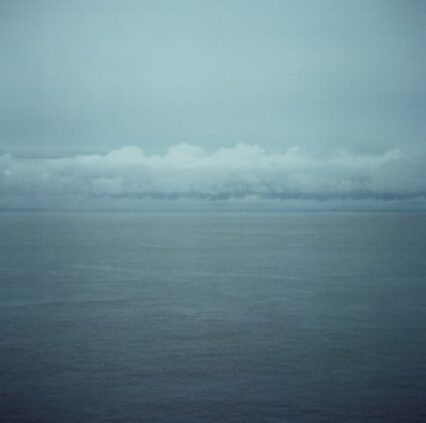
‘B/REACH’
By Byran Marshall
The last time I reached a horizon,
reached only because it beckoned,
it was a cliff, and I had known
that it would be a cliff.
I stumbled down steps stretching down
towards dark, towards stone, towards
something unknown.
Faced with the flat, blank darkness of sea,
diaphanous clouds cast in layers of grey,
and a sky too adept at hiding its sun,
the voice of the unknown spoke
through the stillness:
I am opportunity.
I am freedom.
I am the empty, ready page.
I am a guide.
I contain everything you don’t yet know.
I am distance.
I am mystery.
I am fear.
I am the threat of fear.
I am the darkness of closed eyes, when closed eyes
refuse to open.
When you reach me, when you cross,
look up and I will still, always, be
far away.
You know I am constant.
But are you sure I am inevitable?
You can find out more about the Môrwellian exhibition here.


